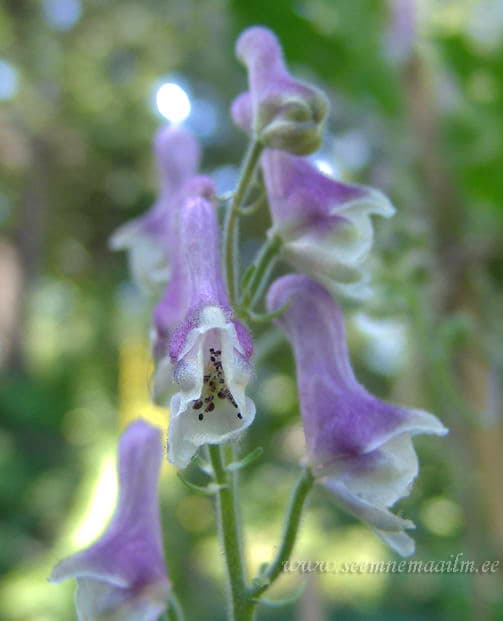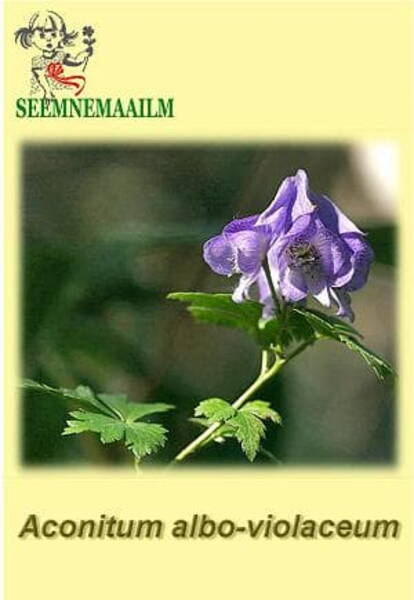Your shopping cart is empty!
Aconite white-violet
Aconite white-violet.
Motherland - south of the Far East, northeast of China. Herbaceous semi-recumbent, semi-climbing plant. Stems up to 250 cm long, densely leafy. Basal leaves on long petioles, large, incised into 5 broad lobes; stem - smaller, on short petioles. The entire plant is covered with short, yellow hairs. Flowers 1.5-2 cm in diameter, white-violet, collected in small racemose inflorescences. Blooms in August-September 50-60 days. Frost-resistant without shelter. It develops well only on rich soils in shady places.
Location: all aconites are frost-resistant unpretentious plants. Curly species grow and bloom better in shady places. Can't stand hot places!
Soil: any cultivated soil is suitable for planting, except for waterlogged, as well as sandy, crushed stone. Does not tolerate stagnant water in autumn!
Care: very responsive to organic and mineral fertilizers, even small doses improve their growth and flowering, respond well to loosening and weeding. It is recommended to mulch the soil 2-3 times per season with a layer of peat 2-3 cm. In dry weather, watering is required. To preserve the decorativeness of plantings, it is necessary to remove faded inflorescences.
Reproduction: seeds, cuttings, dividing the bush or daughter tubers. Seeds are sown in autumn in the year of collection in slightly shaded areas with moist soil. Seedlings appear next spring. When sown in spring, the seeds germinate in a year and their germination is significantly reduced. A two-stage stratification is recommended: in heat at 20-25 degrees for about a month and in cold at 2-4 degrees. up to three months, after which the seeds germinate together at room temperature. At the stage of one or two leaves, the seedlings dive at a distance of 10 cm, and in the fall they are planted in place according to the scheme 25 x 30. Young plants bloom in 2-3 years.
For cuttings, young herbaceous shoots 10-12 cm high are used, which develop in early spring from overwintered tubers. Older shoots due to lignification do not take root.

Motherland - south of the Far East, northeast of China. Herbaceous semi-recumbent, semi-climbing plant. Stems up to 250 cm long, densely leafy. Basal leaves on long petioles, large, incised into 5 broad lobes; stem - smaller, on short petioles. The entire plant is covered with short, yellow hairs. Flowers 1.5-2 cm in diameter, white-violet, collected in small racemose inflorescences. Blooms in August-September 50-60 days. Frost-resistant without shelter. It develops well only on rich soils in shady places.
Location: all aconites are frost-resistant unpretentious plants. Curly species grow and bloom better in shady places. Can't stand hot places!
Soil: any cultivated soil is suitable for planting, except for waterlogged, as well as sandy, crushed stone. Does not tolerate stagnant water in autumn!
Care: very responsive to organic and mineral fertilizers, even small doses improve their growth and flowering, respond well to loosening and weeding. It is recommended to mulch the soil 2-3 times per season with a layer of peat 2-3 cm. In dry weather, watering is required. To preserve the decorativeness of plantings, it is necessary to remove faded inflorescences.
Reproduction: seeds, cuttings, dividing the bush or daughter tubers. Seeds are sown in autumn in the year of collection in slightly shaded areas with moist soil. Seedlings appear next spring. When sown in spring, the seeds germinate in a year and their germination is significantly reduced. A two-stage stratification is recommended: in heat at 20-25 degrees for about a month and in cold at 2-4 degrees. up to three months, after which the seeds germinate together at room temperature. At the stage of one or two leaves, the seedlings dive at a distance of 10 cm, and in the fall they are planted in place according to the scheme 25 x 30. Young plants bloom in 2-3 years.
For cuttings, young herbaceous shoots 10-12 cm high are used, which develop in early spring from overwintered tubers. Older shoots due to lignification do not take root.


Eng.: White Monks Hood., Monkshood. Suom.: Köynnösukonhattu.












